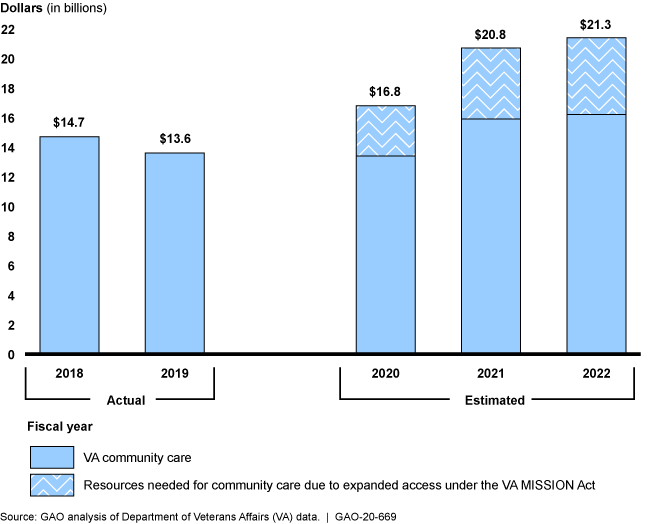VA Health Care: Additional Steps Could Help Improve Community Care Budget Estimates
Fast Facts
Most veterans seeking Department of Veterans Affairs medical services use its 170 medical centers or over 1,000 outpatient facilities. Veterans may also use community care—services from non-VA providers—in some cases, such as when they face long waits or drive times to VA facilities. Congress expanded access to community care beginning in June 2019.
The VA estimates community care will cost $21.3 billion in FY 2022—a 45% increase from FY 2018—in part because of the recent expansion.
We found ways the VA could improve its actuarial modeling and make its budget estimates more reliable. We recommended it make these improvements.
Resources Needed by the Department of Veterans Affairs for Community Care, FY 2018-2022

Highlights
What GAO Found
To help ensure veterans' access to timely health care services, the Department of Veterans Affairs (VA) purchases care from non-VA providers, known as community care. VA estimates that by fiscal year 2022, its obligations for veterans' community care will total $21.3 billion, an increase of $6.6 billion (45 percent) from fiscal year 2018. This estimated increase reflects implementation of the VA MISSION Act of 2018, which, among other things, expanded veterans' access to community care starting in June 2019.
VA Actual and Estimated Community Care Obligations, Fiscal Years 2018 through 2022

aTotals may not sum due to rounding.
Each year, VA develops an estimate of the budgetary resources needed to provide VA health care services, including community care, by following established processes. However, when providing data to its consultant responsible for the actuarial modeling, VA does not communicate all relevant information on the quality of its community care utilization and cost data, including any limitations affecting these data. VA officials responsible for providing the data told GAO that they rely on the offices that compile and validate the data for use throughout the department, without collecting information on the data quality from those offices. Such information could improve the actuarial modeling. In addition, VA does not fully assess and communicate to stakeholders the degree of uncertainty inherent in actuarial projections for community care that directly inform the community care budget estimates. VA officials told GAO that stakeholders have an awareness that actual community care experience may differ from projections. By fully assessing and communicating the degree of overall uncertainty associated with its projections, however, VA stakeholders would have more comprehensive information for responding to uncertainty affecting model projections when making decisions regarding VA's community care budget estimates.
Why GAO Did This Study
In fiscal year 2019, VA obligations for veterans' community care accounted for over 17 percent of all obligations for VA health care. In implementing the VA MISSION Act of 2018, VA continues to focus on community care as a way to improve veterans' access to health care. When informing Congress of the resources needed for community care, VA must ensure its budget estimates, which are based mostly on actuarial projections, are reliable. The process to develop these estimates is inherently complex, as it requires making assumptions based on imperfect information.
GAO was asked to review VA's efforts to develop projections for community care. This report (1) describes VA's actual community care obligations for fiscal years 2018 and 2019 and estimated obligations for fiscal years 2020 through 2022 and (2) examines VA's processes related to its use of actuarial modeling for developing budget estimates for community care, among other objectives. GAO reviewed VA data and documents used to develop estimates for the budget requests for fiscal years 2020 through 2022, the most recent years for which data and documents were available. GAO also interviewed officials from VA and its actuarial consultant responsible for developing estimates.
Recommendations
GAO recommends that VA (1) communicate information on data quality to its actuarial consultant and (2) assess and communicate overall uncertainty associated with actuarial projections to stakeholders. VA concurred with GAO's recommendations.
Recommendations for Executive Action
| Agency Affected | Recommendation | Status |
|---|---|---|
| Department of Veterans Affairs | The Under Secretary for Health should establish steps for communicating to VA's actuarial consultant information on data quality, including any limitations, used in the actuarial modeling that informs VA's community care budget estimates. (Recommendation 1) |
VA agreed with our recommendation. According to VA documentation, the department established in 2024 a workgroup consisting of officials from VA and its actuarial consultant. The purpose of the workgroup includes communicating information on community care data quality among other things. VA documentation confirms that information regarding quality of the community care data has been communicated to its actuarial consultant during monthly meetings of the workgroup.
|
| Department of Veterans Affairs | The Under Secretary for Health should establish further steps for assessing and communicating to stakeholders the degree of overall uncertainty associated with actuarial projections for community care that inform the community care budget estimates. (Recommendation 2) |
VA agreed with our recommendation. According to VA documentation, VHA's Office of Enrollment and Forecasting developed a risk communication to stakeholders regarding the degree of overall uncertainty associated with the actuarial projections used to support the President's Budget, including the community care budget estimates. VHA's Office of Enrollment and Forecasting provided the VHA Office of Finance with pandemic modeling documentation, a major driver of the fiscal year 2022 President's Budget request, that explicitly documents the various sources of uncertainty and provides range of associated costs. VA incorporated this risk assessment into its Congressional Budget Justification for fiscal years 2022 and 2023.
|
